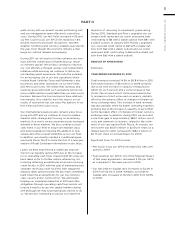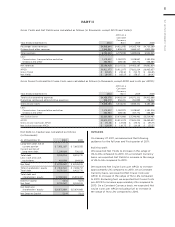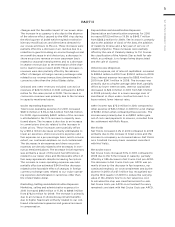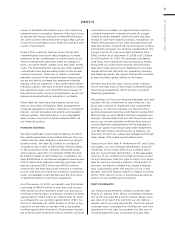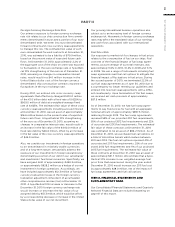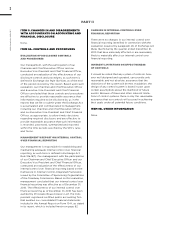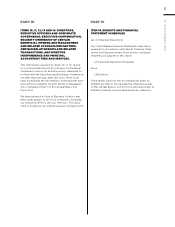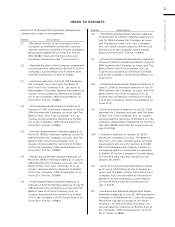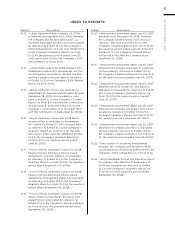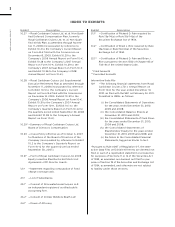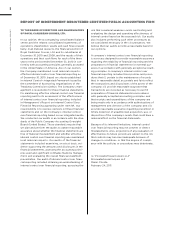Royal Caribbean Cruise Lines 2010 Annual Report Download - page 55
Download and view the complete annual report
Please find page 55 of the 2010 Royal Caribbean Cruise Lines annual report below. You can navigate through the pages in the report by either clicking on the pages listed below, or by using the keyword search tool below to find specific information within the annual report.
2010 ANNUAL REPORT 52
PART II
payments in excess of any new financings for the past
four quarters. Our minimum net worth and maximum
net debt-to-capital calculations exclude the impact of
accumulated other comprehensive income (loss) on
total shareholders’ equity. We are currently well in
excess of all debt covenant requirements. The specific
covenants and related definitions can be found in the
applicable debt agreements, the majority of which
have been previously filed with the Securities and
Exchange Commission.
DIVIDENDS
During the first three quarters of 2008, we paid out
dividends totaling $128.0 million. Commencing in the
fourth quarter of 2008, our Board of Directors discon-
tinued the issuance of quarterly dividends. As a result,
we did not declare cash dividends in 2010 or 2009.
ITEM 7A. QUANTITATIVE AND QUALITATIVE
DISCLOSURES ABOUT MARKET RISK
FINANCIAL INSTRUMENTS AND OTHER
General
We are exposed to market risk attributable to changes
in interest rates, foreign currency exchange rates and
fuel prices. We manage these risks through a combi-
nation of our normal operating and financing activities
and through the use of derivative financial instruments
pursuant to our hedging policies and procedures. The
financial impacts of these hedging instruments are
primarily offset by corresponding changes in the
underlying exposures being hedged. We achieve this
by closely matching the amount, term and conditions
of the derivative instrument with the underlying risk
being hedged. We do not hold or issue derivative
financial instruments for trading or other speculative
purposes. We monitor our derivative positions using
techniques including market valuations and sensitivity
analyses. (See Note 13. Fair Value Measurements and
Derivative Instruments to our consolidated financial
statements under Item 8. Financial Statements and
Supplementary Data.)
Interest Rate Risk
Our exposure to market risk for changes in interest
rates relates to our long-term debt obligations and
our operating lease for Brilliance of the Seas. At
December 31, 2010, approximately 49% of our long-
term debt was effectively fixed and approximately
51% was floating. We enter into interest rate swap
agreements to modify our exposure to interest rate
movements and to manage our interest expense and
rent expense.
Market risk associated with our long-term fixed rate
debt is the potential increase in fair value resulting
from a decrease in interest rates. We use interest rate
swap agreements that effectively convert a portion of
our fixed-rate debt to a floating-rate basis to manage
this risk. In an effort to increase our percentage of
fixed rate debt, during 2010, we terminated our inter-
est rate swap agreements that effectively changed
€1.0 billion of debt with a fixed rate of 5.625% to
EURIBOR-based floating rate debt. We also terminated
our cross currency swap agreements that effectively
changed €300.0 million of the €1.0 billion floating
EURIBOR-based debt to $389.1 million of floating
LIBOR-based debt. Upon termination of these swaps,
we received net cash proceeds of approximately
$115.4 million. At December 31, 2010, we maintained
interest rate swap agreements that effectively changed
$350.0 million of debt with a fixed rate of 7.25% to
LIBOR-based floating rate debt plus a margin of 1.72%,
currently approximately 2.18%.
The estimated fair value of our long-term fixed rate
debt at December 31, 2010 was $4.9 billion using
quoted market prices, where available, or using the
present value of expected future cash flows which
incorporates risk profile. The fair value of our interest
rate swap agreements including accrued interest
was estimated to be an asset of $57.3 million as of
December 31, 2010 based on the present value of
expected future cash flows. A hypothetical one percent-
age point decrease in interest rates at December 31,
2010 would increase the fair value of our long-term
fixed rate debt by approximately $187.7 million, net of
an increase in the fair value of the associated interest
rate swap agreements.
Market risk associated with our long-term floating
rate debt is the potential increase in interest expense
from an increase in interest rates. A hypothetical one
percentage point increase in interest rates would
increase our 2011 interest expense by approximately
$37.9 million, assuming no change in exchange rates.
Market risk associated with our operating lease for
Brilliance of the Seas is the potential increase in rent
expense from an increase in sterling LIBOR rates. We
have effectively changed 49% of the operating lease
obligation from a floating rate to a fixed rate obligation
with a weighted-average rate of 4.76% through rate
fixings with the lessor. A hypothetical one percentage
point increase in sterling LIBOR rates would increase
our 2011 rent expense by approximately $1.5 million,
based on the exchange rate at December 31, 2010.



